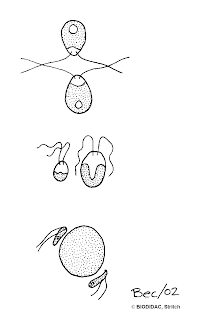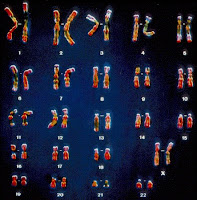 |
"Mommy, Where Do Gametes Come From?"
"I'm glad you asked that, Honey. We usually don't see gametes, but just because they are small doesn't mean they're not important."You see, gametes are special haploid cells produced by a kind of cell division called 'meiosis'. Two gametes can unite to form a diploid cell again. That's called 'fertilization' or 'syngamy'. Diploid cells have a set of pairs of chromosomes, but haploid cells have just one copy of each chromosome. In people, most cells have 23 pairs of chromosomes. Chickens have 39 pairs of chromosomes in their diploid cells. Mosquitoes have 4, isn't that cute?
 |
"And there's a second thing even more wonderful about meiosis, Dear. When the pairs of sister chromatids are in the pachytene stage of prophase I, non-sister chromatids can exchange some of their DNA by 'crossing over'. So the DNA from
 |
"All this shuffling and exchanging of DNA means that the baby that grows from the zygote formed by the union of those two gametes probably has a unique set of genes never born on Earth before! Of course if the zygote splits into twins, they will each have the same genetic makeup, but you get the idea.
"This way of making babies is called 'sexual reproduction'. Lots of different life forms do it, but not always in the same way. Bacteria and archaea don't do it at all, since they can't do meiosis. Still, they seem to get along OK. In fact, they are the dominant life forms on our planet!
 |
"Lots and lots of eukaryotes have meiosis and fertilization as part their life cycle. Did you know that we are eukaryotes? We (or our ancestor eukaryotes) evolved meiosis and most of us have never given it up. It is strongly selected by natural selection. One result of the more flexible evolution that results from using sexual reproduction is the origin over the ages of so many new species with so many different ways of living -- like us, Pumpkin! That's why people have sex! Isn't that interesting?"
"Yes, I guess so. . . . Mommy, what are 'cells'?"
Two good articles:
Wikipedia on Evolution of Sex
Good review article

No comments:
Post a Comment